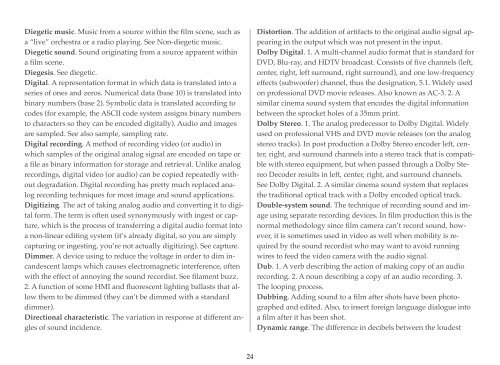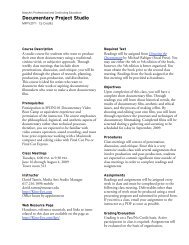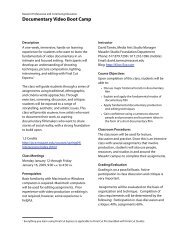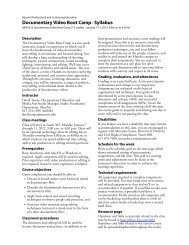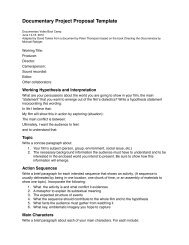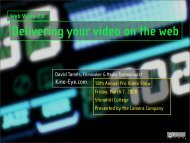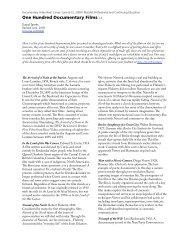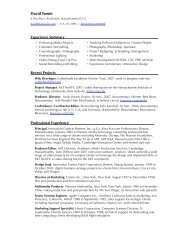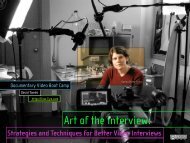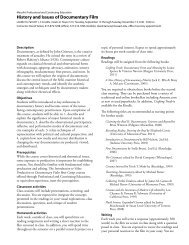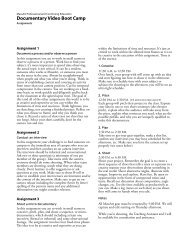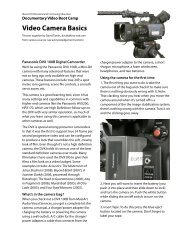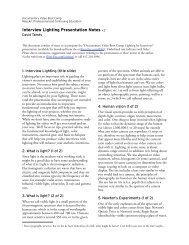Sound for Documentary
Sound for Documentary
Sound for Documentary
You also want an ePaper? Increase the reach of your titles
YUMPU automatically turns print PDFs into web optimized ePapers that Google loves.
Diegetic music. Music from a source within the film scene, such as<br />
a “live” orchestra or a radio playing. See Non-diegetic music. <br />
Diegetic sound. <strong>Sound</strong> originating from a source apparent within<br />
a film scene. <br />
Diegesis. See diegetic. <br />
Digital. A representation <strong>for</strong>mat in which data is translated into a<br />
series of ones and zeros. Numerical data (base 10) is translated into<br />
binary numbers (base 2). Symbolic data is translated according to<br />
codes (<strong>for</strong> example, the ASCII code system assigns binary numbers<br />
to characters so they can be encoded digitally). Audio and images<br />
are sampled. See also sample, sampling rate. <br />
Digital recording. A method of recording video (or audio) in<br />
which samples of the original analog signal are encoded on tape or<br />
a file as binary in<strong>for</strong>mation <strong>for</strong> storage and retrieval. Unlike analog<br />
recordings, digital video (or audio) can be copied repeatedly without<br />
degradation. Digital recording has pretty much replaced analog<br />
recording techniques <strong>for</strong> most image and sound applications.<br />
Digitizing. The act of taking analog audio and converting it to digital<br />
<strong>for</strong>m. The term is often used synonymously with ingest or capture,<br />
which is the process of transferring a digital audio <strong>for</strong>mat into<br />
a non-linear editing system (it’s already digital, so you are simply<br />
capturing or ingesting, you’re not actually digitizing). See capture. <br />
Dimmer. A device using to reduce the voltage in order to dim incandescent<br />
lamps which causes electromagnetic interference, often<br />
with the effect of annoying the sound recordist. See filament buzz.<br />
2. A function of some HMI and fluorescent lighting ballasts that allow<br />
them to be dimmed (they can’t be dimmed with a standard<br />
dimmer). <br />
Directional characteristic. The variation in response at different angles<br />
of sound incidence. <br />
24<br />
Distortion. The addition of artifacts to the original audio signal appearing<br />
in the output which was not present in the input. <br />
Dolby Digital. 1. A multi-channel audio <strong>for</strong>mat that is standard <strong>for</strong><br />
DVD, Blu-ray, and HDTV broadcast. Consists of five channels (left,<br />
center, right, left surround, right surround), and one low-frequency<br />
effects (subwoofer) channel, thus the designation, 5.1. Widely used<br />
on professional DVD movie releases. Also known as AC-3. 2. A<br />
similar cinema sound system that encodes the digital in<strong>for</strong>mation<br />
between the sprocket holes of a 35mm print.<br />
Dolby Stereo. 1. The analog predecessor to Dolby Digital. Widely<br />
used on professional VHS and DVD movie releases (on the analog<br />
stereo tracks). In post production a Dolby Stereo encoder left, center,<br />
right, and surround channels into a stereo track that is compatible<br />
with stereo equipment, but when passed through a Dolby Stereo<br />
Decoder results in left, center, right, and surround channels.<br />
See Dolby Digital. 2. A similar cinema sound system that replaces<br />
the traditional optical track with a Dolby encoded optical track. <br />
Double-system sound. The technique of recording sound and image<br />
using separate recording devices. In film production this is the<br />
normal methodology since film camera can’t record sound, however,<br />
it is sometimes used in video as well when mobility is required<br />
by the sound recordist who may want to avoid running<br />
wires to feed the video camera with the audio signal. <br />
Dub. 1. A verb describing the action of making copy of an audio<br />
recording. 2. A noun describing a copy of an audio recording. 3.<br />
The looping process. <br />
Dubbing. Adding sound to a film after shots have been photographed<br />
and edited. Also, to insert <strong>for</strong>eign language dialogue into<br />
a film after it has been shot. <br />
Dynamic range. The difference in decibels between the loudest


